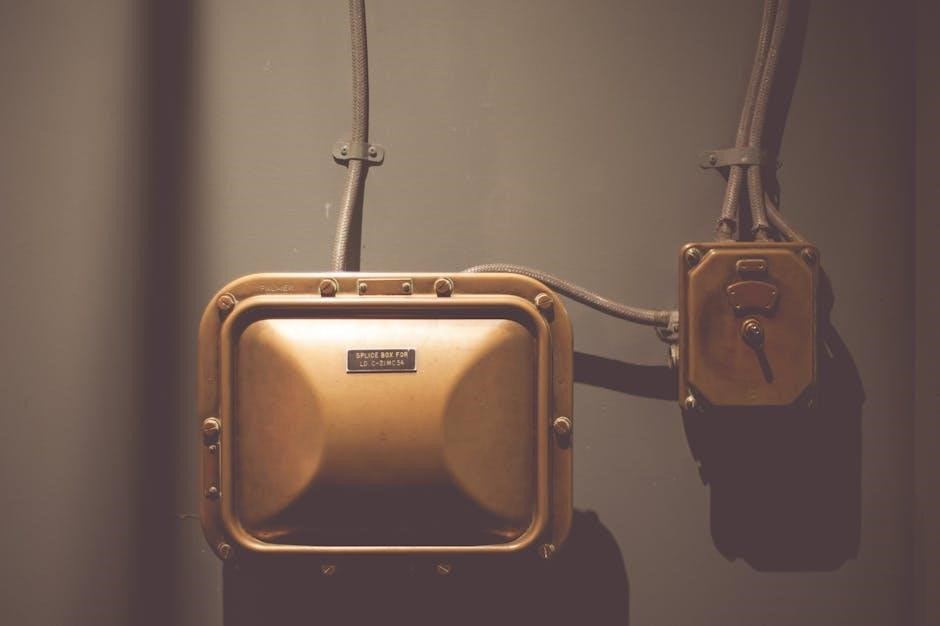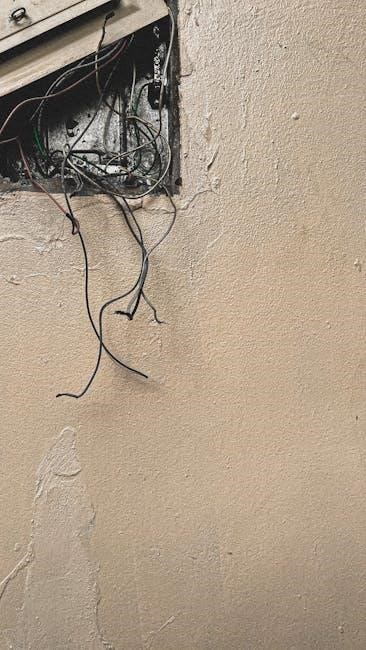
An electrical wiring diagram is a detailed blueprint for installing and connecting electrical systems in a house. It uses symbols to represent components, connections, and circuits, ensuring safe and efficient installations. These diagrams are essential for technicians and homeowners to understand how electricity flows through the system, helping in troubleshooting and maintaining electrical integrity. They also guide compliance with safety standards and regulations, making them indispensable for both new constructions and renovations.
1.1 Purpose of Wiring Diagrams
Wiring diagrams serve as visual guides for planning, installing, and troubleshooting electrical systems in a house. They provide a clear representation of circuit connections, components, and their relationships, ensuring that electrical installations are done safely and efficiently. These diagrams act as blueprints, helping electricians and homeowners identify the correct placement of wires, outlets, switches, and other devices. They also simplify the process of diagnosing and resolving electrical issues, reducing the risk of hazards. By standardizing electrical connections, wiring diagrams promote compliance with safety regulations and industry standards, making them an indispensable tool for both professionals and DIY enthusiasts. Their clarity and precision ensure that electrical systems function optimally and remain safe for years.
1.2 Importance of Wiring Diagrams
Wiring diagrams are crucial for ensuring the safety, efficiency, and compliance of electrical installations in a house. They provide a clear and detailed visual representation of the electrical system, helping to prevent hazards and ensure proper connections. By following these diagrams, electricians and homeowners can avoid overloaded circuits, short circuits, and other potential dangers. Wiring diagrams also facilitate compliance with local electrical codes and regulations, reducing legal and safety risks. They simplify the process of understanding complex electrical systems, making it easier to identify components, troubleshoot issues, and plan future modifications. Ultimately, wiring diagrams are essential for maintaining the reliability and safety of a home’s electrical infrastructure, serving as an invaluable resource for both installation and maintenance.
1.3 Types of Wiring Diagrams
Electrical wiring diagrams are categorized into several types, each serving specific purposes. The most common include schematic diagrams, which use symbols to represent components and connections, and pictorial diagrams, which provide a visual layout of the system. Line diagrams simplify complex circuits into straightforward representations, making them easier to understand. Wiring diagrams can also be categorized by their application, such as residential, commercial, or industrial. Additionally, they may focus on specific systems like lighting, power distribution, or control circuits. Each type of diagram offers a unique perspective, aiding electricians and homeowners in planning, installing, and maintaining electrical systems efficiently and safely;

Key Electrical Components
Key electrical components include wires, circuits, switches, outlets, circuit breakers, and fuses. These elements work together to distribute and control electrical power safely and efficiently in a house.
2.1 Wires and Cables
Wires and cables are the backbone of any electrical system, responsible for conducting electricity throughout a house. They are categorized by their gauge (thickness), insulation type, and conductor material (copper or aluminum). Insulation ensures safety by preventing electrical shocks and fires. Thicker wires, like those used in main supply lines, can handle higher currents, while thinner ones are suitable for lighting and small appliances. Proper sizing and installation of wires are critical to avoid overheating and ensure reliable power distribution. Using high-quality, durable wires minimizes the risk of electrical hazards and guarantees long-term system performance.
2.2 Electrical Circuits
Electrical circuits are pathways through which electricity flows to power devices in a house. They consist of wires, switches, outlets, and circuit breakers or fuses, forming a closed loop. Circuits are designed to distribute power safely and efficiently, ensuring that appliances and lighting operate correctly. Properly installed circuits prevent overheating and electrical hazards. They are categorized into types like radial or ring main systems, each serving specific needs. Understanding circuit operation is crucial for troubleshooting and maintaining electrical systems. Always follow safety guidelines when working with circuits to avoid risks and ensure reliable power distribution throughout the home.
2.3 Switches and Outlets
Switches and outlets are essential components in electrical wiring systems, enabling control and access to power. Switches regulate the flow of electricity to lights, fans, and appliances, while outlets provide connection points for devices. Common types include single-pole, three-way, and dimmer switches, each serving specific functions. Outlets, such as standard duplex receptacles, GFCI-protected outlets, and USB outlets, cater to various power needs. Proper installation ensures safety and functionality, adhering to local electrical codes. Wiring diagrams detail the connections between switches, outlets, and circuits, guiding installers for correct setup. Regular maintenance and inspection are crucial to prevent hazards and ensure reliable operation. Understanding their roles is key for safe and efficient electrical system management.
2.4 Circuit Breakers and Fuses
Circuit breakers and fuses are critical components in electrical systems, serving as protective devices to prevent damage from overloads or short circuits. Circuit breakers automatically interrupt power when a fault is detected, while fuses melt to break the circuit. They ensure safety by isolating faulty sections, preventing fires, and protecting equipment. Modern systems often use circuit breakers due to their reset capability, while fuses are more common in older installations. Types include GFCI (ground fault circuit interrupters) and AFCI (arc fault circuit interrupters), which address specific hazards. Proper sizing and installation are vital for reliable operation. Regular inspection is recommended to maintain system integrity and ensure compliance with safety standards. These devices are indispensable for safeguarding both people and property in residential electrical setups.

Types of House Wiring Systems
House wiring systems include radial, ring main, and series configurations, each designed to distribute electricity efficiently and safely throughout a home, ensuring reliability and meeting specific needs.
3.1 Radial Wiring System
The radial wiring system is a common method used in residential electrical installations. It involves running a single cable from the main electrical panel to individual outlets or fixtures, creating a branch circuit. This system is straightforward and cost-effective, as each outlet is directly connected to the power source. Radial wiring is ideal for homes with minimal electrical demands, offering simplicity in installation and maintenance. However, it may not be as efficient in larger buildings due to the potential for voltage drop over long cable runs. Proper planning ensures that each circuit is adequately sized to handle the connected loads, maintaining safety and efficiency in the electrical distribution.
3.2 Ring Main Wiring System
The ring main wiring system is a reliable and efficient method for distributing electricity in homes. It involves connecting all outlets and fixtures in a loop, where the live and neutral wires form a continuous ring. This configuration ensures that power is evenly distributed, reducing voltage drop and providing consistent supply. The ring main system is particularly suitable for larger houses with higher electrical demands, as it offers better fault tolerance and flexibility. If one part of the circuit fails, the rest remains functional, minimizing disruptions. Proper installation requires careful planning to ensure the loop is correctly formed, and all connections are secure, ensuring safe and efficient operation of the electrical system.
3.3 Series Wiring System
The series wiring system connects electrical components one after another in a single path. This configuration is straightforward but less common in modern homes due to its limitations. In a series circuit, the same current flows through all devices, meaning if one component fails or is switched off, it disrupts the entire circuit. This setup is often used in specific applications like holiday lights or simple control circuits. However, it is not ideal for household wiring because it does not allow for independent operation of devices. Series wiring requires careful planning to avoid overloading and ensure safety, as faults can affect the entire system. It is generally recommended for niche applications rather than comprehensive home wiring solutions.

Safety Precautions in Electrical Wiring
Always turn off the power supply before starting work. Use protective gear like gloves and goggles. Follow wiring diagrams and test circuits before energizing. Avoid overloaded circuits and ensure compliance with safety standards to prevent shocks or injuries.
4.1 General Safety Tips
Always disconnect the power supply before starting electrical work to prevent shocks. Use insulated tools and wear protective gear like gloves and goggles. Avoid overloaded circuits and ensure all connections are secure. Follow the wiring diagram carefully and test circuits with a multimeter before energizing. Keep work areas clean and well-lit to minimize hazards. Never work on live circuits or in damp conditions. Ensure proper grounding of equipment and avoid using damaged cables. Turn off the main power switch if you suspect an electrical issue. Regularly inspect wiring for signs of wear or damage. Adhere to local electrical codes and safety standards to ensure a safe installation. Always consult a professional if unsure about any procedure;
4.2 Protective Gear and Equipment
Protective gear is essential for safe electrical work. Insulated gloves prevent electrical shocks, while safety goggles protect eyes from debris. Use a voltage-rated multimeter to test live circuits safely. Steel-toe boots and flame-resistant clothing provide additional protection. Ensure all tools are insulated and in good condition. A first-aid kit should always be nearby in case of emergencies. Use a non-contact voltage tester to verify de-energized circuits. Proper lighting, like LED flashlights, is crucial for visibility in dark spaces. Avoid jewelry that could conduct electricity. Always use a ladder with non-conductive side rails when working at heights. Wearing a dust mask can protect against airborne particles during drilling or wiring. Never compromise on using high-quality, certified protective equipment to minimize risks during electrical tasks.
4.3 Emergency Procedures
In case of an electrical emergency, stay calm and act quickly. First, switch off the main power supply at the circuit breaker or disconnect the main switch. Use a fire extinguisher rated for electrical fires (e.g., CO2) if a fire occurs. Never use water on electrical fires. Evacuate the area immediately, especially if there’s a risk of fire spreading. Call emergency services if the situation is beyond control. If someone is electrocuted, turn off the power source before touching them. Use a non-conductive object to free them if necessary and administer first aid or CPR if they are unresponsive. Always prioritize safety and avoid risky interventions. Regular inspections and maintenance can prevent many electrical emergencies, ensuring a safer living environment.

Reading and Interpreting Wiring Diagrams
Understand the symbols and notations to identify components and connections. Trace circuits to see how electricity flows through wires, switches, and devices. Follow color coding conventions for clarity.
5.1 Understanding Symbols and Notations
Mastering symbols and notations is crucial for interpreting wiring diagrams. Symbols represent components like switches, outlets, and circuit breakers, while notations indicate connections and wire types. Common symbols include circles for switches, rectangles for outlets, and zigzag lines for resistors. Notations like “L1” or “L2” denote live wires, while “N” stands for neutral. Pictorial diagrams use images, while schematic diagrams use abstract symbols. Understanding these elements helps technicians and homeowners trace circuits and identify how electricity flows through the system. Proper interpretation ensures safe and correct installations, avoiding hazards. Color coding also plays a key role, with black for hot wires, white for neutral, and copper for ground. Familiarity with these conventions is essential for accurate readings and troubleshooting.
5.2 Identifying Circuit Connections
Identifying circuit connections is essential for understanding how electricity flows through a house. Wiring diagrams show live, neutral, and ground wires, helping trace connections between devices like switches, outlets, and circuit breakers. By following the diagram, one can pinpoint where each wire leads and how components interact. This skill is vital for installations, troubleshooting, and ensuring safety. For instance, live wires (often black) carry power, while neutral wires (white) complete the circuit. Ground wires (bare copper) provide a safe path for excess current. Properly identifying these connections helps prevent hazards and ensures the system operates efficiently. Always verify connections with a multimeter before working on them to avoid shocks or short circuits.
5.3 Color Coding and Conventions
Color coding and conventions in wiring diagrams ensure clarity and consistency. Live wires are typically black, neutral wires white, and ground wires green or bare copper. These colors help technicians quickly identify wire functions, reducing errors. Conventions like standardized symbols for switches, outlets, and circuit breakers make diagrams universally understandable. Color coding also highlights phase differences in three-phase systems, with phases marked as black, red, and blue. Adhering to these conventions ensures safety and efficiency, preventing misconnections that could lead to electrical hazards. Proper training in recognizing and applying these standards is crucial for anyone working with electrical systems. Always refer to local regulations for any variations in color coding practices.
Common Wiring Configurations
Common wiring configurations include two-way and three-way switches for lighting control, multiple lighting circuits for distributed power, and radial wiring for single-point power distribution. These setups ensure efficient and safe electrical connections, optimizing performance and reducing the risk of overloading circuits. Proper configuration adherence is crucial for maintaining system reliability and meeting safety standards. This section provides detailed insights into standard wiring setups used in residential electrical systems.
6.1 Two-Way Switch Configuration
A two-way switch configuration is a fundamental setup in home electrical wiring, allowing control of a single light or appliance from two different locations. This configuration typically involves three wires: a line wire, a neutral wire, and a common wire. The line wire carries the power supply, while the neutral completes the circuit. The common wire connects to the load, such as a light fixture. The switches are installed at each control point, with the common wire linking them. Proper wiring ensures that the circuit functions correctly, enabling seamless operation of the controlled device from either switch. This setup is widely used in staircases, hallways, and large rooms for convenient lighting control.
6.2 Three-Way Switch Configuration
A three-way switch configuration is designed to control a single light or appliance from three different locations, offering enhanced convenience in larger spaces. This setup requires four wires: two traveler wires, a line wire, and a neutral wire. The traveler wires connect the switches, enabling the circuit to be controlled from multiple points. The line wire carries the power supply, while the neutral completes the circuit. Each switch is wired to the traveler wires, allowing the current to flow through different paths depending on the switch positions. This configuration is ideal for long hallways, spacious rooms, or areas with multiple access points, ensuring flexible and efficient lighting control without the need for additional wiring.
6.3 Multiple Lighting Circuits
Multiple lighting circuits allow for efficient and safe distribution of electrical power to various lighting fixtures throughout a house. Each circuit is designed to handle a specific area or group of lights, preventing overloading and ensuring reliability. These circuits are typically connected in parallel, enabling individual control of each light or group. The main advantage of multiple lighting circuits is that a fault in one circuit does not affect others, maintaining functionality elsewhere. Proper wiring diagrams are essential to plan and install these circuits correctly, ensuring compliance with safety standards and efficient energy use. This configuration is ideal for large homes or buildings with diverse lighting needs, providing flexibility and redundancy in the electrical system.

Troubleshooting Common Electrical Issues
Troubleshooting electrical issues involves identifying faults like flickering lights, tripped breakers, or short circuits. Use wiring diagrams to trace connections and diagnose problems effectively, ensuring safety and efficiency.
7.1 Identifying Common Faults
Identifying common faults in electrical systems often starts with analyzing symptoms like flickering lights, frequent circuit breaker trips, or warm outlets. These issues may indicate overloaded circuits, loose connections, or short circuits. Using a wiring diagram helps trace power flow and pinpoint where faults occur. For instance, if multiple lights dim when an appliance starts, it could signal a voltage drop due to high current demand. Checking for faulty switches or improperly grounded wires is also crucial. By systematically reviewing connections and components, homeowners and electricians can diagnose issues efficiently, ensuring safety and preventing potential hazards like electrical fires.